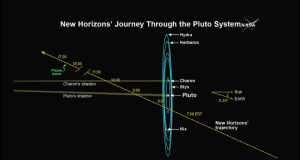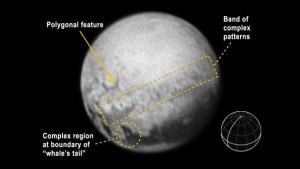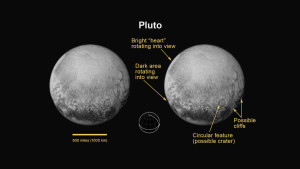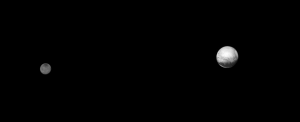Peter Lobner
New Horizons is rapidly approaching Pluto for a fast fly-by encounter with closest approach at 7:49 am on Tuesday, 14 July 2015. You’ll find basic information about the New Horizons mission in my 14 March 2015 post on this subject. Detailed information is available at the NASA New Horizons mission website at the following link:
https://www.nasa.gov/mission_pages/newhorizons/main/index.html
The spacecraft will fly past Pluto at 30,800 mph (49,600 kph), and is expected to fly within 7,750 miles (11,265 km) of Pluto’s surface. The close-encounter segment of the flyby is quite brief, as shown in the following diagram of New Horizon’s trajectory through the Pluto system.
 Source: NASA/Applied Physics Laboratory/Southwest Research Institute
Source: NASA/Applied Physics Laboratory/Southwest Research Institute
On 9 July, New Horizon’s Long Range Reconnaissance Imager (Lorri) took the following photo from a range of 3.3 million miles. Some basic surface features have been noted by the NASA project team, along with a diagram indicating Pluto’s north pole, equator, and central meridian.
Source: NASA/Applied Physics Laboratory/Southwest Research Institute
On 11 July, the project team released the following slightly more detailed photo that reveals linear features that may be cliffs, as well as a circular feature that could be an impact crater.
Source: NASA/Applied Physics Laboratory/Southwest Research Institute
Below is a photo released on 9 July showing both Pluto and it’s largest moon, Charon, which orbit each other around their common center of gravity. You’ll find more information on the unusual orbital interactions among Pluto and it’s five known moons in my 6 June 2015 post on that subject.
Source: NASA/Applied Physics Laboratory/Southwest Research Institute


